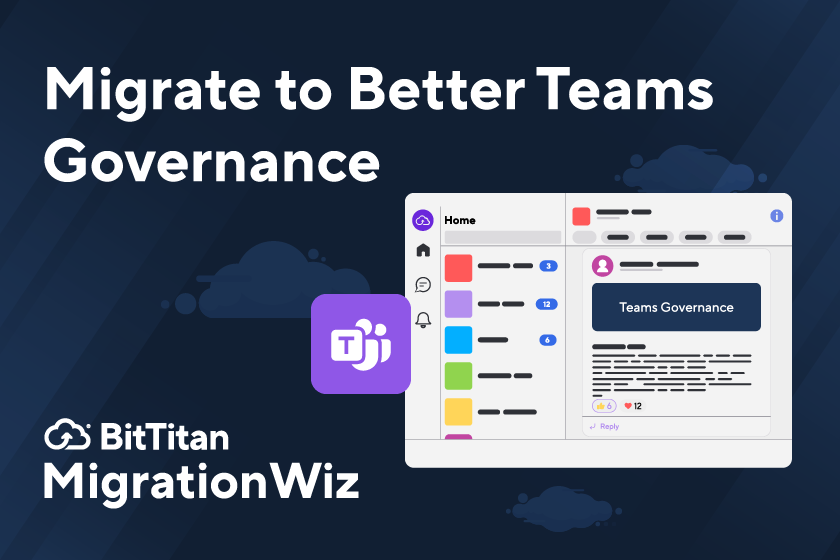Migrate to Better Teams Governance
Microsoft Teams has revolutionized the way people work. The platform’s features allow for a lot of flexibility in how people collaborate and access resources. But many organizations are discovering, after a few years of experience, that flexibility needs to be balanced with control.
An increasingly common concern among IT administrators is Teams Sprawl. Teams Sprawl manifests in different ways. It can often lead to security and compliance issues. Productivity can also be impacted when users have trouble navigating the platform. Sprawl can cost real money if teams and files and channels grow without periodic pruning.
You can use a planned migration to address issues in your Teams environment. When the organization is already preparing for a change, it’s a good time to formalize policies that support improvements in Teams management. Governance means establishing and communicating policies that help users understand their role in maintaining a healthy Teams environment.
Fortunately for users of MigrationWiz, the tool already migrates conversations, channel memberships, channels and users’ teams. Those items coupled with document permissions will ensure the work you have already done at your Source tenant will remain intact and transition over to the Destination seamlessly.
What Teams Governance Looks Like
Many organizations have spun up Teams without formal governance policies. Others are studying how Teams is being used in their organization, and addressing behaviors that would have been impossible to anticipate when it was first adopted. Common Teams governance policies include:
Naming and classification. Establishing standard naming and classification conventions makes teams easier to find and helps avoid duplicates. Naming can also be used to identify teams that are no longer relevant to active projects.
Creation. Just because you can give all users the ability to create teams doesn’t mean you should. It often makes sense to limit who is able to create a team. This can vary by department, and it doesn’t have to be centralized in IT.
Lifespan. People can be very enthusiastic about creating teams, but they usually neglect to delete them at the end of a project. Your governance policy can require expiration dates for teams along with a periodic review to identify any that are inactive or irrelevant. You can also specify which types of teams you’ll archive in order to preserve their content.
Data retention. Your organization likely has retention policies to address compliance requirements and data security. These policies should also apply to Teams and SharePoint files.
Access control. If you start by defining Teams users by type, such as creator, owner, member, and guest, you can then outline the process for managing team membership. You should also include protocols for adding and removing guests like vendors and partners and for determining who gets access to which features and files.
Integrating Governance into a Migration
You may be hesitant to spring a new governance scheme on your organization if you think it might stir up confusion. That’s why a migration presents such a good opportunity. You’ll likely discover things during pre-migration planning that will guide new policies. This will also help you communicate the reasons for making the change. For example, if people are complaining that they’re having a hard time finding information, let them know they’re being heard by instituting better naming and classification schemes. Here are some steps to consider as part of your migration planning:
Ask the experts. Start by learning from IT team members about the frustrations or concerns coming their way. They may be hearing about hard-to-locate files, out-of-control teams, hard-to-use resources, and under-used features. Your team may also have concerns about privacy, security, and compliance. They probably also have a good idea which departments are the Teams power users versus which are lagging. A good first draft of your governance policies can come from the inside. But don’t stop there. And keep in mind the old adage, “If it ain’t broke, don’t fix it.”
Assess the environment. Your migration should include an assessment of the environment so you can determine the type and volume of workloads that you’ll be moving. This gives you the information you’ll need to get the right number of licenses, figure out the duration of the migration, and decide if it makes sense to archive items ahead of time. All this is standard pre-migration work. But you can also use your pre-migration assessment to identify issues that can be addressed with better Teams governance.
Ask more experts. Choose a stakeholder from each department or business line who can give you insights about how their colleagues use Teams. Ask what kind of challenges they’re having, and what problems need solving. Use this group to vet different policy options so you can gauge how users will respond. Once the new governance policy is launched, these representatives can provide clarity to their teams about how certain rules will work.
Communicate well and often. Once you’ve documented the new Teams governance policies, make sure they get to every user along with instructions about the migration itself. This might involve working with HR or Marketing to target people through town halls, emails, messaging, or team meetings. Most IT teams with migration experience know they have to send multiple communications, sometimes over different channels, so everyone is made aware.
Migrating Teams gives you a great opportunity to establish a new Teams environment that reflects the lessons you’ve learned in the old environment. A proactive approach to governance enhances security and compliance and helps control Teams Sprawl. But most of all it helps users get the most out of Teams through added efficiency and greater productivity. To learn more or to get started on a project please contact us, we’re happy to help.


